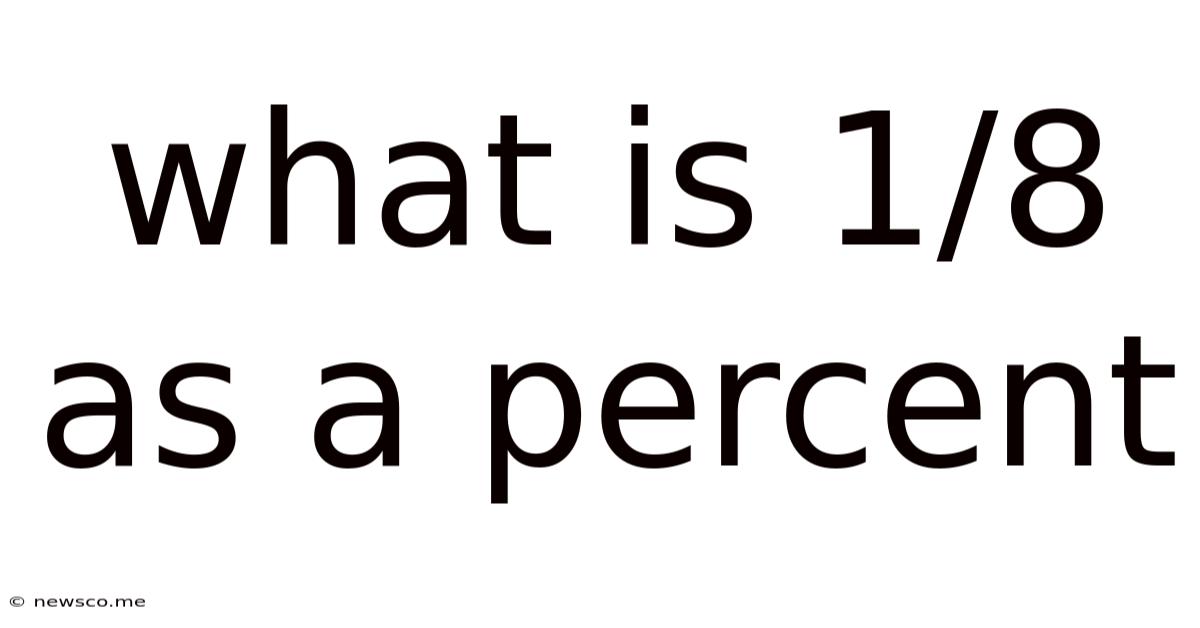What Is 1/8 As A Percent
News Co
Mar 24, 2025 · 5 min read

Table of Contents
What is 1/8 as a Percent? A Comprehensive Guide
Understanding fractions and their percentage equivalents is a fundamental skill in mathematics with applications spanning various fields. This comprehensive guide delves into the conversion of the fraction 1/8 into a percentage, explaining the process step-by-step and providing practical examples to solidify your understanding. We'll also explore related concepts and applications to build a strong foundation in this area.
Understanding Fractions and Percentages
Before diving into the conversion, let's refresh our understanding of fractions and percentages.
Fractions: A fraction represents a part of a whole. It's expressed as a ratio of two numbers: the numerator (top number) and the denominator (bottom number). For instance, in the fraction 1/8, 1 is the numerator and 8 is the denominator. This means we have 1 part out of a total of 8 equal parts.
Percentages: A percentage represents a fraction of 100. It indicates how many parts out of 100 make up the whole. The symbol "%" denotes percentage. For example, 50% means 50 parts out of 100, which is equivalent to the fraction 50/100 or 1/2.
Converting 1/8 to a Percentage: The Step-by-Step Process
There are two primary methods for converting 1/8 to a percentage:
Method 1: Using Decimal Conversion
-
Divide the numerator by the denominator: Divide 1 by 8. This gives you 0.125.
-
Multiply the decimal by 100: Multiply 0.125 by 100. This yields 12.5.
-
Add the percentage symbol: Add the "%" symbol to indicate that the result is a percentage.
Therefore, 1/8 is equal to 12.5%.
Method 2: Finding an Equivalent Fraction with a Denominator of 100
-
Find a number to multiply the denominator to get 100: Since 8 multiplied by 12.5 equals 100, we'll use 12.5 as our multiplier.
-
Multiply both the numerator and the denominator by the same number: Multiply both the numerator (1) and the denominator (8) by 12.5. This gives us 12.5/100.
-
Express as a percentage: Since the denominator is 100, the numerator directly represents the percentage. Therefore, 12.5/100 is equivalent to 12.5%.
Practical Applications of 1/8 as a Percentage
Understanding the percentage equivalent of 1/8 is useful in many real-life situations:
-
Calculating Discounts: A store might offer a 1/8 discount on an item. Knowing that this is equivalent to 12.5% makes it easier to calculate the final price.
-
Measuring Ingredients: In cooking or baking, recipes might call for a fraction of an ingredient. Converting this fraction to a percentage can be helpful for adjusting the recipe proportionally. For example, if a recipe calls for 1/8 cup of sugar, you know that's 12.5% of a cup.
-
Understanding Data and Statistics: In data analysis or statistics, percentages are commonly used to represent proportions. Understanding 1/8 as 12.5% helps in interpreting data presented in percentage form.
-
Financial Calculations: Interest rates, taxes, and other financial calculations often involve percentages. Converting fractions to percentages aids in these calculations.
-
Geometry and Measurement: Calculating areas, volumes, and other geometric properties might involve fractions. Converting fractions to percentages allows for easier comparisons and understanding of proportions.
Related Fraction to Percentage Conversions
Understanding the conversion of 1/8 to a percentage allows for a better understanding of other fraction-to-percentage conversions. Here's a table showing some common fractions and their percentage equivalents:
| Fraction | Percentage |
|---|---|
| 1/2 | 50% |
| 1/4 | 25% |
| 1/5 | 20% |
| 1/8 | 12.5% |
| 1/10 | 10% |
| 1/16 | 6.25% |
| 3/4 | 75% |
| 2/5 | 40% |
| 3/8 | 37.5% |
| 5/8 | 62.5% |
Advanced Concepts: Working with Percentages in Calculations
Once you understand the basic conversion, you can apply this knowledge to more complex calculations.
-
Calculating Percentage Increase or Decrease: For example, if a quantity increases by 1/8, this represents a 12.5% increase. Similarly, a decrease by 1/8 represents a 12.5% decrease.
-
Finding a Percentage of a Number: To find 12.5% of a number, you multiply the number by 0.125 (the decimal equivalent of 12.5%). For instance, 12.5% of 100 is 100 * 0.125 = 12.5.
-
Working with Compound Percentages: In some scenarios, you might need to work with multiple percentages. For example, calculating a discount followed by a tax would involve applying percentages sequentially.
Troubleshooting Common Errors in Percentage Conversions
While converting fractions to percentages is straightforward, certain errors might occur:
-
Incorrect Decimal Placement: Ensure you accurately place the decimal point when converting the fraction to a decimal and then multiplying by 100.
-
Misunderstanding of Multiplication and Division: Carefully execute the multiplication and division steps to avoid calculation mistakes.
-
Not Adding the Percentage Symbol: Remember to include the "%" symbol to represent the result as a percentage.
Conclusion: Mastering Fraction-to-Percentage Conversions
Converting fractions to percentages is a valuable skill with widespread applications. Understanding the process for converting 1/8 to 12.5% provides a solid foundation for working with various fractions and percentages in different contexts. By mastering this skill, you'll be better equipped to handle various mathematical problems and real-world situations involving proportions and ratios. Remember to practice regularly to solidify your understanding and build confidence in your ability to perform these conversions accurately and efficiently. The ability to effortlessly switch between fractions and percentages will greatly enhance your mathematical proficiency and problem-solving capabilities across various disciplines.
Latest Posts
Related Post
Thank you for visiting our website which covers about What Is 1/8 As A Percent . We hope the information provided has been useful to you. Feel free to contact us if you have any questions or need further assistance. See you next time and don't miss to bookmark.